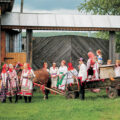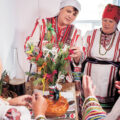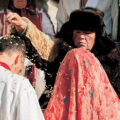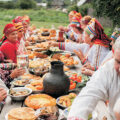- Свадебный поезд / Wedding train
- Родственницы жениха украшают пирог курник / Groom’s relatives decorating the kurnik pie
- «Ряженый медведь» встречает жениха и невесту / “Dressed-up bear” meeting the bride and groom
- Свадебный пир в доме жениха / Wedding feast at the groom’s house
The Erzya wedding is interesting and distinctive in its way of combining elements of two cultures: pagan and Orthodox. The description of the wedding ceremony was written down by researchers from the words of the women of the village of Podlesnaya Tavla in Mordovia who got married according to the traditions of the Erzya wedding.
Choosing a bride and matchmaking
Before a wedding takes place, various preparations need to be performed, such as preliminary matchmaking, engagement, matchmaking itself, gifts preparation, maiden’s bath, bride’s porridge, farewell to home, baking pies.
Once the decision on the wedding is made, praying starts in the groom’s family. Each family has its own ancestral candle to be put on the table alongside bread and salt during the praying. Every family member participates in praying and appeals to Vere Paz (the Almighty God), Kudon Kirdi (the Keeper of the House), and the deceased ancestors with a request to help them fulfill their plans. During the praying, a “forward-goer” is appointed to negotiate with the bride’s parents.
The forward-goer can go to the fence of the bride’s house at night and leave bread and a whip there. If the bride’s parents take them home early in the morning, it means that they are ready to negotiate. If the gifts remain untouched, it means that the bride’s parents are not yet ready to give their daughter in marriage.
Sometimes, the forward-goer goes immediately to the bride’s parents, taking with him “shumbra kshi” (bread for health), a rolling pin, and a pan gripper to scare away evil spirits. After some time, the day of the official matchmaking is appointed. Before the matchmaking day, praying in the groom’s house commences again. On this day, the matchmakers take bread, salt, fish, and home brew with them, perform amulet rituals (putting a coin under the heel, sticking needles in homespun coats), and go to the bride’s house. The groom does not participate in the matchmaking. With the bride’s price and dowry settled, the groom’s and bride’s parents shake their hands to make a wedding deal. They call for the bride and tell her about the upcoming wedding. The bride begins to wail and cry. If she doesn’t know how to do it, a special keener is invited.
Preparing for the wedding
Senior females of the village of Podlesnaya Tavla recall that this leg of the ceremony consists of the rite of the betrothal, viewing of the bride, viewing of the groom’s house, purchasing of gifts, appointing of the wedding day, the day of porridge, stuffing of the chest, and a maiden’s bath. All this can last from a week to six months.
Wedding
The wedding day starts early at dawn. A special kurnik pie is baked in the groom’s house to be decorated with twigs and ribbons. In the morning of the same day, the groom goes to the bathhouse, takes a shower, and puts on his wedding clothes. The bride meets her female friends who come to take her to a neighbor’s house to protect her from the “evil eye”. In the morning, this neighbor cooks millet porridge and feeds all the girls. Then, the bride puts on her wedding clothes in front of the stove, with her friends braiding her hair. After that, they lead the bride back to her parent’s house along the laid straw, not letting her thus step on the ground.
While the bride is dressing up, the groom’s relatives bake pies and stuff the dowry chest with bread, fish, ribbons, and home brew. Once settled, the groom’s brothers or friends take the chest and carry it to the wedding train headed by the female matchmaker. As soon as the wedding train is ready to depart, the groom’s godfather or the groom’s elder brother or best man circles it three times drawing crosses on all sides. Sometimes, the groom may stay home and wait for the bride to be brought to him. The meeting of the wedding train at the bride’s house is similar to Russian wedding traditions: the bride’s friends and her relatives lock the doors and demand a ransom from those who arrive. Then, the groom’s relatives go into the house, put pies and other food on the table, and thank the bride’s parents. The bride says goodbye to her house, bows to her parents, her home, relatives, friends, goes out into the yard, and sits in a cart decorated with ribbons. At this moment, no one sees her face, it is covered with a wedding shawl, which only the groom can take off. When the wedding train arrives at the groom’s house, the groom approaches the cart and helps the bride get off. He opens her face, and they approach the groom’s parents for a blessing. On the threshold of the house, a “dressed-up bear” welcomes the couple, showers them with hops, makes jokes, and then checks if the bride is kind or evil: a frying pan with hops is placed on the floor, and the bride must push it forward with her foot. If all the hops spill out on the floor, the bride is evil, if they stay in the pan, the bride is kind.
As for the wedding feast, the bride never participates in it. As soon as the young couple enters the house, she is immediately taken to get acquainted with Kashtomava, the stove goddess. Once the festivities are over, the young people are locked up for the night in a bathhouse or a barn, with the “dressed-up bear” sitting at the entrance to guard them and making sounds with stones or sticks to set up the rhythm of the wedding night.
After the wedding
In the early morning, the daughter-in-law goes to the well with a yoke buckets to get water and get acquainted with the spirits of the local well. Her mother-in-law is watching her closely. If the daughter-in-law splashes water on her way back home, with buckets half-empty, she is believed to be a bad housewife. If the water stays in the buckets, a baby is expected.
On this day, a young couple accompanied by the dressed-up guests has to walk through all the streets of their village. The one who comes out to meet them with treats is believed to get happiness to their house. The couple, however, cannot taste the treats lest bad spells or the evil eye occur. The fun lasts in the village for 3–7 days. Each of the groom’s relatives tries to invite the young couple to their house during this week. Thus, the bride gets acquainted with the whole family of the groom.
The traditional Erzya wedding is always accompanied by music. No action takes place without wedding lamentations or songs. Each wedding leg is filled with artistic and poetic content.
The legs of the Erzya wedding ceremony described above only partially reflect all the richness and abundance of this event in the Mordovian folk tradition and represent separate scenes of the main wedding moments.
Ekaterina Modina, General Director of the Center for Traditional Folklore and Ethnography
Denis Knyazev, photographer, author of the project




